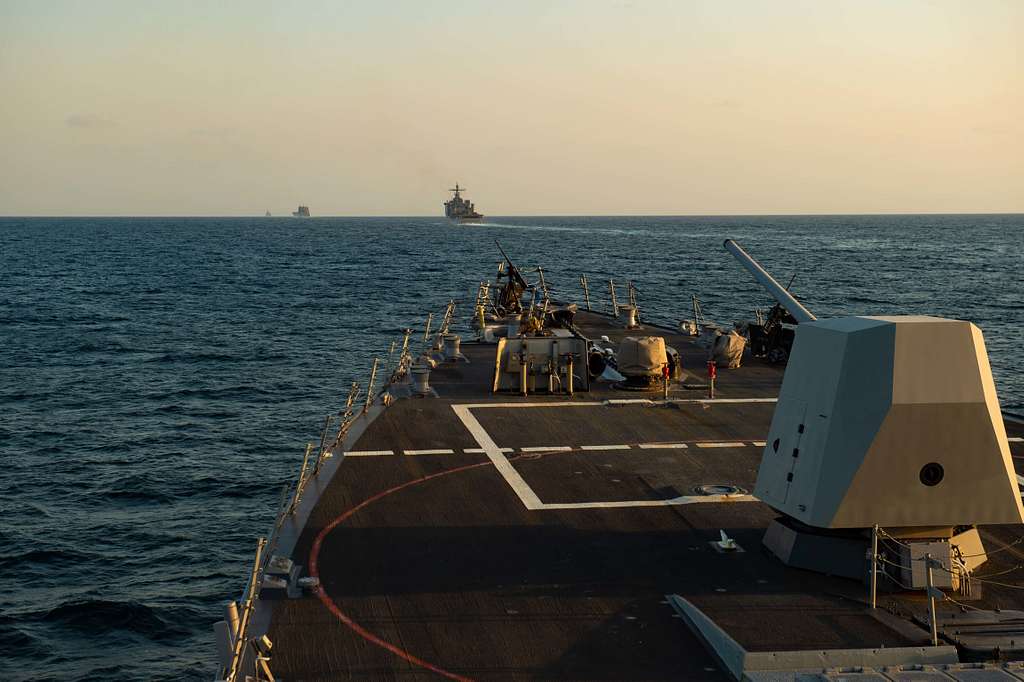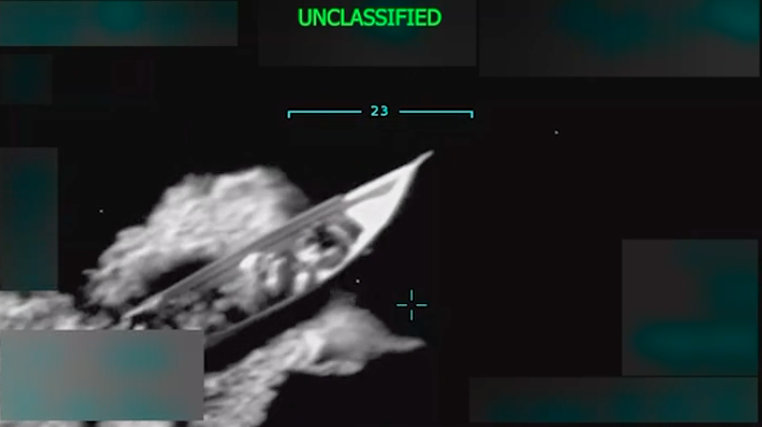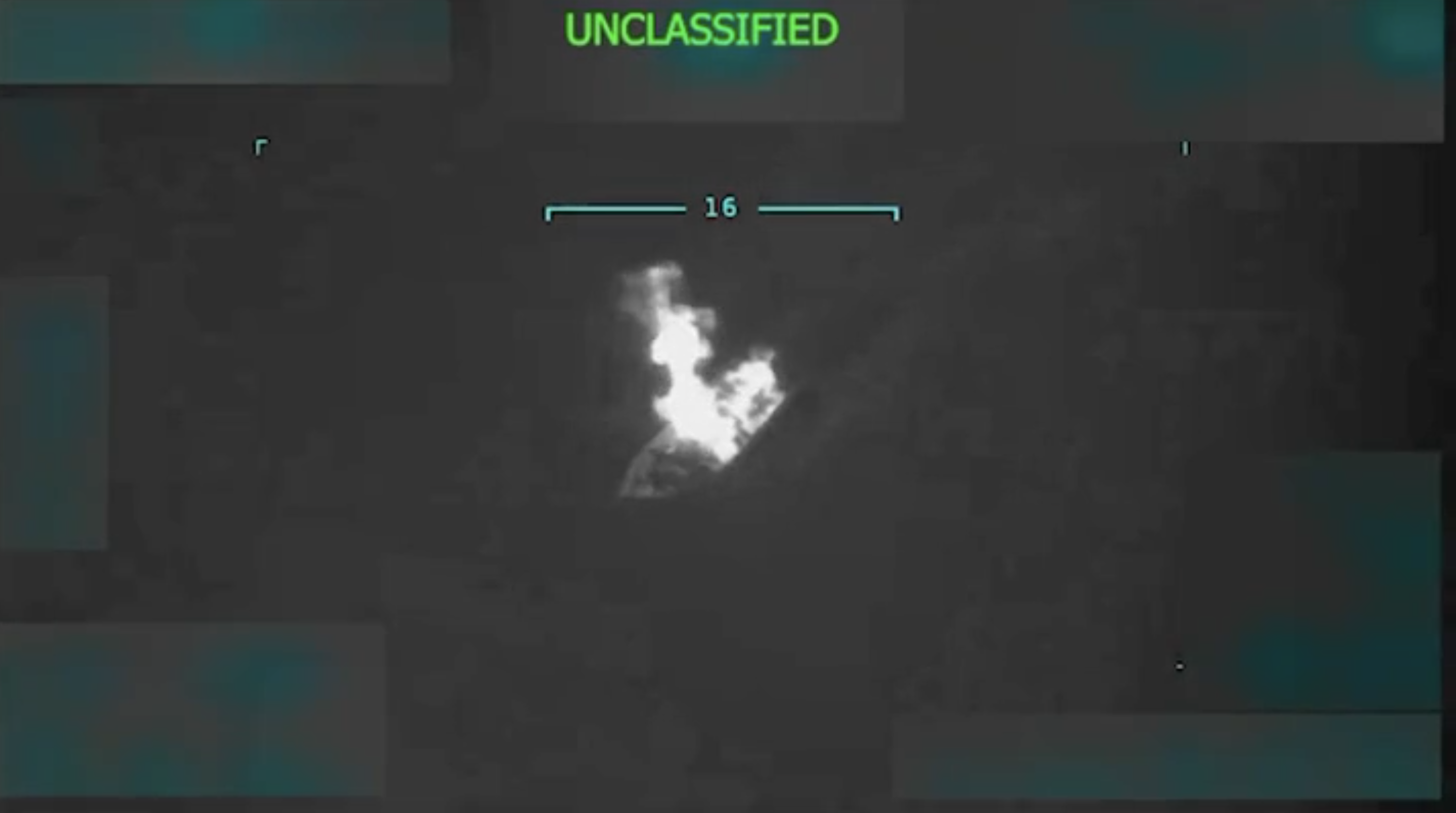Attacks on U.S. Warships Justify Self-Defense Against Houthi Forces Ashore

Published by The Lawfare Institute
in Cooperation With

Iran-backed Houthi rebels in Yemen are conducting missile and drone attacks against international shipping in the Red Sea and the Gulf of Aden. Over the past month, the Houthis have launched more than 100 drone and missile attacks against 10 merchant ships. And they have seemingly targeted vessels at random. However, at least two attacks were conducted directly against U.S. warships: one by Houthi missiles and the other by a drone swarm. On Dec. 31, 2023, U.S. forces sank three Houthi small boats that were attacking a Maersk merchant vessel. The Americans acted in unit self-defense after the small boats fired on them. While the U.S. Navy turned back the attacks, Houthi drones and missiles pose an ongoing and imminent threat to the U.S. exercise of freedom of navigation in the Red Sea and the Gulf of Aden.
The Houthi movement is officially known as Ansar Allah and is an organized armed group (OAG) that seeks to take over all of Yemen. On Nov. 21, Houthi armed forces made a helicopter-borne raid on the merchant ship Galaxy Leader, capturing the ship and 25 crew members. The Bahamas-flagged ship is chartered by Japan’s Nippon Yusen and owned by Galaxy Maritime Ltd in the Isle of Man. The rebel group released video of the visit, board, search, and seizure (VBSS) as they raised Yemeni and Palestinian flags on the ship and held the vessel and crew hostage at anchorage at Al-Hudaydah. The crew consists of 17 Filipino nationals, two Bulgarians, three Ukrainians, two Mexicans, and one Romanian citizen.
On Dec. 3, the Houthis fired ballistic missiles that struck three more commercial vessels. Three days later, the USS Mason shot down a suicide drone in the Red Sea, presumably also launched by the Houthis. The Norwegian motor tanker Strinda was struck by at least one missile on Dec. 12; three days later a Liberia-flagged container ship transiting the Bab al-Mandeb (BAM) was hit by an unknown projectile fired from the coast of Yemen. The USS Mason came under attack from two Houthi anti-ship missiles on Dec. 13. The two missiles missed the Mason, which shot down an incoming drone. By Dec. 15, the Houthis had attacked at least eight ships in the Strait of BAM. Then, on Dec. 16, Houthi forces attacked a U.S. warship, the USS Carney, sailing in the Red Sea. The Carney fended off a barrage of 14 suicide drones. That same day, the British warship HMS Diamond (D34) shot down a drone launched by Houthi forces targeting merchant shipping.
These attacks come nearly three years after the Biden administration removed the global terrorist organization label from the Houthis. Smart and credible strategy requires the United States to exercise self-defense and launch naval attacks in Yemeni territory to destroy Houthi aircraft, drone, and missile facilities and infrastructure. The Dec. 13 and Dec. 16 attacks on the USS Mason and USS Carney, respectively, provide a basis under international law for the U.S. to respond by conducting defensive strikes on Houthi infrastructure and personnel in Yemeni territory, which the U.S. and its partners appear to be considering. Defensive strikes would be a lawful response to stop attacks on U.S. warships exercising the right of freedom of navigation in the Gulf of Aden and the Red Sea. Deterrence will be restored only by the destruction of Houthi air and missile complexes in Yemen that are capable of attacking U.S. warships.
Missile Alley
The Gulf of Aden is more than 50 percent larger than the Persian Gulf and connects the Arabian Sea to the Red Sea, which serves as the conduit to the Suez Canal. This is the principal international highway connecting Europe and the Mediterranean Sea with trading partners in South and East Asia and the Middle East. Twelve percent of global trade transits the Red Sea, including over 8 percent of the world’s oil supplies. Because of the attacks on international shipping, half of the normal international shipping traffic has been rerouted around Africa, extending the time of a trip to Europe by 25 percent.
After a missile narrowly missed an A.P. Moller - Maersk container ship, the company announced it was avoiding the strait altogether but weeks later abruptly shifted course and resumed shipping in the region. (Then an attack on the Maersk ship mentioned above called on the shipping firm to change course yet again). Other shipping firms are also navigating around the strait, including Norway-based Frontline oil tanker group and MSC, the world’s biggest freight shipping line. The Red Sea is now designated a high-risk area for marine insurance.
This Isn’t Piracy
Over the past few years, the Houthi threat had some of the trappings of maritime piracy. The U.S. has responded to the menace in the Red Sea in the same way it did to counter Somali pirates in 2009—by forming an international task force to share the burden of protecting freedom of the seas. The Red Sea patrol is based on the U.S. experience with piracy, but two notes of caution are in order. First, the Houthi threat is orders of magnitude greater than the threat from Somali piracy. Somali pirates used small arms to capture ships and hold their crews for ransom. The Houthis are using ballistic missiles and drone swarms to strike ships. Second, contrary to popular belief, a decade ago warships had a relatively muted effect in reducing maritime piracy in the Western Indian Ocean. The U.S. initiated Combined Task Force (CTF) 151 to counter rampant piracy, and the effort was a complete diplomatic success.
But CTF 151 always had more value in optics and building partnerships than in providing tangible results on the water. Back then, the area of the Western Indian Ocean susceptible to piracy was over 2 million square miles. For a coalition warship to effectively rescue a ship under attack by pirates, it had to be located within 15 minutes of the scene of attack. It took only a few minutes for pirates to get on board a commercial ship, and once a ship was boarded, it was almost impossible to intervene without endangering the crew. CTF 151 brought together three dozen navies under a common cause and demonstrated U.S. leadership, but the incidence of piracy plummeted in the Somali Basin mainly due to reasons other than warship patrols.
The shipping industry quickly implemented best management practices (BMP) to harden ships by adding razor concertina wire around the lifelines that made boarding more difficult. The BMP included a suite of additional protective measures, such as zig-zag steaming, deceptive lighting, and training the crew to repel boarders using fire hoses. Some vessels were equipped with long-range acoustic devices (LRADs) that emit ear-piercing sound to ward off approaching small boats. The most secure ships were outfitted with armored citadels into which the crew could sequester if the ship was boarded by pirates. Although the BMP were effective, the most significant measure to defeat Somali piracy was the positioning on board commercial ships of government vessel protection detachments (VPDs) and privately contracted armed security personnel (PCASP). Active or former military personnel serving as armed guards at sea were effective in virtually ending Somali piracy. Pirates soon learned they were no match for a small defensive team with superior weapons and training, and who occupied higher ground on the upper decks of an international ocean-going ship. This was a constabulary exercise in maritime law enforcement. Active-duty military personnel and outsourced private security contractors operated under international human rights rules governing the use of force. Deadly force was permitted only when it was reasonable and necessary under the circumstances to protect human life.
So far, the U.S. strategy in the Gulf of Aden borrows a page from the playbook that was used to defend against Somali piracy: The U.S. formed a multinational naval task force to protect merchant vessels. The effort is called Operation Prosperity Garden, and it includes the United Kingdom, Bahrain, France, Norway, and other countries. Like CTF 151, Prosperity Garden has asked states to contribute warships to patrol the sea lanes. But this strategy will be a disappointment if the Houthis are treated like Somali pirates. The strategy may help protect merchant ships, but it also creates more targets for the Houthis. Even though the Houthis, like Somali pirates, are non-state actors, they are organized and equipped like a conventional military force. The Houthis, similar to Hezbollah or Hamas, are a state within a state; they must be dealt with as a state would be dealt with—which means in the fashion of an armed conflict. This is not a maritime law enforcement operation but, rather, armed conflict at sea. The law of naval warfare, not maritime law enforcement, applies in this situation. Under this framework, Houthi forces in Yemen that are targeting ships on the high seas should be engaged and destroyed.
Self-Defense Against Houthi Forces
What would be the lawful basis for naval strikes against Houthi targets in Yemen? The UN General Assembly’s 1974 definition of aggression includes “[a]n attack by the armed forces of a State on the land, sea or air forces, or marine and air fleets of another State.” Each of the attacks on the USS Mason and the USS Carney individually qualifies as aggression. The Houthis are not a state but a clan-based Shia Islamist military organization in control of the northern part of Yemen. The definition of aggression generally applies to states but also may apply to entities like the Houthis that are functionally a state, since the definition itself is “used without prejudice to questions of recognition [of statehood]….” Iran has armed the Houthi group with ballistic missiles and drones capable of striking Israel 1,000 miles from Sanaa. The Toufan, Burkan, and Quds missiles based on Iranian models, for example, may have a range of as long as 1,200 miles.
Against such a force, national self-defense may be taken to counter the imminent and ongoing threat of future attacks. Military necessity suggests that all diplomatic efforts must be exhausted before force can be used. The U.S. diplomatic policy of appeasement has failed, and deterrence is not working. The daily attacks on international shipping serve as sufficient evidence of the exhaustion of diplomatic efforts. U.S. warships operating in the Gulf of Aden, the Red Sea, and the Strait of BAM are in danger.
Any U.S. response in self-defense would be governed by the law of armed conflict. The use of force in the name of self-defense requires that the action taken be proportional to the threat. In this case, destruction of the means of war employed by the Houthi movement to threaten freedom of the seas is a proportional response because it is required to repel the ongoing armed attack and restore the security of the sea lanes. States may act in self-defense when it is reasonably necessary to discourage future armed attacks or threats. For example, in 1986, when the United States informed the UN Security Council of strikes against Libya, it stated, “The United States objective was to destroy facilities used to carry out Libya’s hostile policy of international terrorism and to discourage Libyan terrorist attacks in the future. These facilities constituted essential elements which have enabled Libyan agents to carry out deadly missions against U.S. installations and innocent individuals.”
States’ views differ on whether they believe they may exercise self-defense against non-state threats. Their thinking on the question is “all over the map.” The United States based its 2021 attacks against Iran-supported non-state actors operating in eastern Syria on the law of self-defense. Australia takes a similar view that states have a right to use force against OAGs “where the territorial State is unwilling or unable to prevent such attacks originating from its territory.” Between 2001 and 2021, 19 states have “identified or referred to non-State actors in their article 51 notifications” at the UN Security Council.
In the 1986 Case Concerning Military and Paramilitary Activities in and Against Nicaragua, the International Court of Justice (ICJ) held that self-defense was not available in response to an unlawful use of force that did not reach the “gravity” or “scale and effect” of a conventional attack. In that case, the ICJ rejected the U.S.’s position that it exercised collective self-defense to stop Nicaraguan attacks on neighboring states because, the court held, the Nicaraguan aggression did not rise above the threshold of a conventional attack. The United States has not accepted this standard and authorizes its commanders to use force in self-defense against a hostile act or a demonstration of hostile intent. Even respecting the Nicaragua standard, however, the swarm drone attacks and missile barrages against warships qualify as an armed attack that supports a response in self-defense. Indeed, the ICJ held in the 2003 Case Concerning Oil Platforms that a mine attack against a single warship “might be sufficient to bring into play the ‘inherent right of self-defence.’” (Despite this holding, the ICJ did not support the U.S.’s position that it acted in self-defense against Iranian forces conducting low-intensity mine and missile attacks against international shipping. The U.S. has rejected that decision as well.)
Once the right of national self-defense is invoked, the jus in bello rules governing armed conflict apply to naval operations. In 2016, U.S. State Department Legal Adviser Brian Egan offered this view in a speech at the American Society of International Law:
[O]nce a State has lawfully resorted to force in self-defense against a particular armed group following an actual or imminent armed attack by that group, it is not necessary as a matter of international law to reassess whether an armed attack is imminent prior to every subsequent action taken against that group, provided that hostilities have not ended.
The law of armed conflict is a well-developed body of law that disciplines the use of force, balancing military necessity with humanitarian considerations to ameliorate the effects of war on civilians and civilian objects. Classically, the law of naval warfare applies only among states during armed conflict at sea. The majority view is that the law of naval warfare does not apply to conflicts between states and non-state actors, even against OAGs. The minority view is that in certain cases where the OAG acts like a naval power, they may be dealt with like a belligerent naval power. In this case, there is no practical alternative—maritime law enforcement missions have become a wholly inappropriate response to Houthi attacks. Law enforcement operations will not deter future attacks and may even invite more incidents by positioning additional Western warships inside the Houthi weapon engagement zone.
A New Kind of Naval War
The Houthis do not operate a single warship, yet they are paralyzing shipping in the Red Sea and the Gulf of Aden. Strikes into Yemen would be a new kind of naval war to counter the Houthis’ new method of exercising sea control from the land. The Houthi infrastructure on land that puts at risk commercial ships and warships exercising high seas freedoms should be eliminated. Further, Iran is apparently operating a radar spy ship in the Red Sea that is providing targeting guidance for Houthi missiles and drones. Iran’s ability to transmit targeting data must be neutralized. This means the only effective strategy is to strike the entire Houthi missile, drone, and piloted aircraft enterprise, including the Iranian ship and other offensive capabilities that are used by the Houthis to project power far from Yemeni shores. The Houthi radar and surface-to-air missile complexes that protect the offensive systems must also be disabled or destroyed. The law supports the destruction of the Houthis’ ability to launch attacks on U.S. warships. This is not to suggest that U.S. forces should go further than necessary to destroy the drone and missile (including ballistic missile) infrastructure used to launch attacks on international shipping.
Under the principle of distinction, which is customary international law in both international and non-international armed conflicts, attacks may be directed only against military objectives. In a non-international armed conflict, such as conflict with the Houthis, this would mean that members of a hostile OAG could be attacked along with any of their military objects. Military objects are those that “by their nature, location, purpose or use make an effective contribution to military action and whose total or partial destruction, capture or neutralization, in the circumstances ruling at the time, offers a definite military advantage.” The Newport Manual on the Law of Naval Warfare applies this rule to non-international armed conflicts at sea as a matter of customary international law.
The principle of proportionality complements the principle of distinction and states that even when attacks are justified by military necessity, the expected “incidental loss of civilian life, injury to civilians, damage to civilian objects, or a combination thereof” cannot be “excessive in relation to the concrete and direct military advantage anticipated.” This principle is also considered customary international law applicable in both international and non-international armed conflicts. In the words of U.S. Naval War College Professor Michael Schmitt, cited recently in the Washington Post, “The law is about what was in the mind of the attacker at the time the attacker planned and executed the mission with respect to both the collateral damage they expected to cause and the military advantage they anticipated gaining.”
With respect to planning military operations against the Houthi missile arsenal, Additional Protocol I states that constant care must be exercised to avoid harm to the civilian population, civilians, and civilian objects in all military operations. (The United States does not necessarily consider the “constant care” requirement to be customary international law.) Additionally, when conducting attacks against military objectives, states are obligated to do “everything feasible” and to “take all feasible precautions” to avoid civilian harm. This principle is considered customary international law applicable in both international and non-international armed conflicts. However, the United States takes the position that the qualifier “all” is not reflective of customary international law: “[T]he obligation to take feasible precautions does not require everything that is capable of being done – a standard that would be almost impossible to meet if interpreted literally.”
What is the best means of accomplishing this mission? The U.S. Central Command has not reported how the USS Carney repelled the barrage of 14 drones, although some analysts suggest that the ship may have used the SM-2 missile. The SM-2 costs over $2 million per round. The HMS Diamond used a Sea Viper missile, which costs several million dollars. Endlessly defending against inbound missiles imposes “decisions on cost, inventory and effectiveness as the mission grows.” The cost of the defensive responses must be factored into the tactical decision of how to respond. Patriot anti-air warfare missiles cost about $4 million per round. One American response could be to launch cruise missiles against selected targets in Yemen, as the U.S. did in 2016—an attack that destroyed Houthi radars in Yemen that had been used in attacks against warships. Cruise missiles cost about $1.5 million each. With wars raging in Ukraine and Gaza, and Taiwan in a precarious position, cruise missiles are a more scarce and important resource than they were in the past.
The value of precision munitions and the opportunity costs of squandering them on an OAG suggests that the most effective strikes in Houthi-controlled Yemen would be by aircraft. The benefit of destroying the Houthis’ capacity to menace international shipping is not without other costs. Saudi Arabia and the United Arab Emirates (UAE), for example, support competing factions in the civil war in Yemen. Saudi Arabia supports a measured approach, fearing that the use of force will only further provoke the Houthis, whereas the UAE is pushing for military action. Yet Houthi attacks are not going to end until the Houthis no longer have the capability to wage war on international shipping. This conclusion reflects the judgment of Riad Kahwaji, founder of the Institute for Near East and Gulf Military Analysis, a Dubai-based security research group, who said, “Unless the [United States] bombs the Houthis’ missile launch sites, radars, airfields and boats, its efforts to combat the threat to shipping won’t be effective.”




